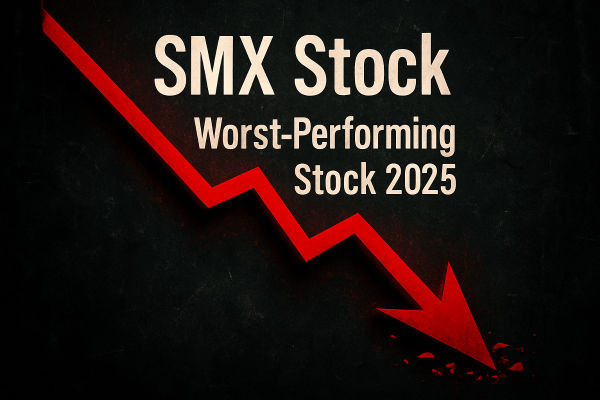Key Takeaways
SMX stock plunged nearly 99% in 2025, ranking among the year's worst U.S. performers.
Weak financials, Nasdaq compliance notices, and heavy dilution drove the collapse.
A 10-for-1 reverse stock split failed to restore investor confidence.
Recovery hinges on revenue traction and stronger governance in 2026.
SMX stock has captured headlines in 2025 as one of the most volatile and underperforming stocks on the U.S. markets. What started as a promising player in anti-counterfeiting and track-and-trace technologies collapsed to devastating lows, prompting questions about what went wrong and if the stock has any path to recovery.
The reasons for its near wipeout include weak financial results, repeated Nasdaq compliance notices, dilutive financing, and investor panic that accelerated selling, a sequence that culminated in a reverse stock split and a share price collapse, leaving SMX among the lowest-returning U.S. stocks in 2025.
This article explores SMX's journey through 2025, highlighting key drivers behind its decline, significant corporate actions, and outlook for investors.
How Bad Was the SMX Stock Decline?

By many measures, SMX's 2025 performance was catastrophic. Year-to-date returns put it in the red far beyond typical small-cap volatility, and screeners tracking worst-performing U.S. stocks listed SMX near the bottom (very close to total value wipeouts reported for other microcaps in 2025).
Public market snapshots in November 2025 show share prices trading in the low single digits (sub-$2 range), down more than 99% year-to-date from a year-ago level that was significantly higher. Multi-day percentage drops and heavy down-volume episodes signalled persistent selling pressure rather than technical blips.
SMX Stock 2025 Timeline: Major Events that Moved the Stock

January–June 2025: Operational and Compliance Red Flags
SMX received public Nasdaq notices and listing delinquency alerts during the year, a clear signal to investors that governance, reporting, or capital structure issues were unresolved.
Companies receiving such notices often face selling pressure from investors, as the uncertainty increases the likelihood of trading suspensions, higher fees, or the need for forced capital measures.
June–September 2025: Dilution and funding rounds
To stay operational, SMX completed follow-on equity offerings and raised small bridge financing in mid-2025.
While the funding provided short-term liquidity, the timing and size of the raises were dilutive, and the market interpreted them as a sign that the company lacked healthy cash flow from operations.
Equity raises by distressed small caps typically trade at discounts and can trigger immediate downward pressure on existing shares.
August–October 2025: Reverse Stock Split Announced and Effective Date Set
As the share price remained depressed, SMX's board approved a reverse stock split to consolidate shares. It is a common strategy to meet minimum bid price requirements and gain eligibility on institutional or retail platforms that restrict stock trading below $1 involves executing a reverse stock split.
In October 2025, a 10-for-1 reverse split was announced, which can temporarily boost the nominal share price but does not affect the company's overall market capitalisation. Such actions are often met with scepticism if underlying business challenges persist. [1]
October–November 2025: Panic Selling and Headline Risk
Following the split and further mixed corporate announcements, share trading experienced massive intraday moves and heavy volume on down days. Short-term technicals turned sharply negative as momentum strategies and retail sellers amplified the move.
Headlines highlighting Nasdaq notices, funding needs, and weak near-term revenue drew new sellers rather than bargain hunters.
What Caused SMX Stock to Collapse? 4 Key Factors

1. Execution and Growth Miss
SMX's early promise in anti-counterfeiting tech couldn't translate into sustained revenue growth. While the company announced partnerships and pilot projects, filings showed limited recurring income to justify prior valuations.
In small-cap growth stories, execution matters more than innovation, and SMX's failure to scale revenue eroded confidence quickly.
2. Repeated Compliance Notices and Governance Concerns
Nasdaq listing notices and "receipt of delinquency" announcements raise questions about financial controls, audit readiness, and board oversight.
Even if a company ultimately remedies the notice, the interim period creates a liquidity-draining uncertainty. Investors tend to value transparency highly, and signals of weak governance accelerate exits.
3. Dilution and Messy Capital Raises
Despite the technology promise, SMX needed outside capital in 2025. The company completed follow-on offerings and smaller funding injections.
Issuing equity at distressed valuations dilutes the value per share for long-term shareholders and increases the total shares outstanding. This dilution usually hampers the potential for price recovery unless accompanied by a significant operational turnaround that restores investor confidence.
4. Market Structure and Momentum Selling
Microcaps with thin free floats are vulnerable to cascades. When a stock falls, stop-loss orders, margin calls, and algorithmic methods can increase the selling pressure.
SMX experienced multiple sessions with steep intraday drops and higher volumes on down days, a classic pattern where negative technicals become a self-fulfilling prophecy.
What SMX Did and How the Market Read It?
Companies in distress can try several playbooks: (a) fight to show commercial traction, (b) restructure the balance sheet, (c) consolidate shares (reverse split), or (d) pivot the business. SMX used a combination:
1. Reverse Stock Split (10:1)
Company: Announced October 23, 2025, to regain compliance and improve optics.
Market Reaction: Tepid. Investors viewed it as cosmetic, and not structural, since it didn't address cash burn or growth problems.
2. Business Development and Partnership Announcements
Company: Continued to announce partnerships in plastics, precious metals, and textiles, expanding the total addressable market.
Market: Sceptical. Partnerships without recurring revenue fail to rebuild credibility. Investors want contracts, not just headlines.
Recent press releases in late 2025 emphasise deployments and partnerships, but these have yet to reverse the slide.
Taken together, the corporate actions failed to shift the overall narrative as operational challenges remain unaddressed, and the balance sheet continues to appear fragile.
Why Reverse Splits Rarely Solve the Underlying Problem?
Reverse splits are mostly optical adjustments. They raise the share price per unit but do not improve fundamentals or enterprise value.
While they can help regain listing eligibility, lasting recovery depends on profitability and governance, not cosmetic changes.
In SMX's case, the reverse split was seen as a last-resort move, highlighting distress rather than turnaround momentum. [2]
Is There Any Reason for Cautious Optimism About SMX Stock?
There's a narrow, conditional path to optimism. SMX retains intellectual property related to product authentication and traceability and maintains ongoing partnerships for 2025. [3]
If these collaborations generate multi-quarter recurring revenue and management restores transparency, the company could begin rebuilding trust.
Conservative investors should watch for:
Consecutive revenue growth quarters
Clear path to positive operating cash flow
Resolution of Nasdaq compliance notices
Assurance against further dilution.
Until then, SMX remains a speculative bet rather than a recovery play.
SMX Stock vs Other 2025 Worst-Performing Stocks
| Ticker |
Company |
Approximate YTD % Return 2025 |
Notes |
| SMX |
Security Matters |
-99.72% |
One of the most extreme cases of collapse among microcaps. |
| DGLY |
Digital Ally |
-99.84% |
Another microcap with near-total wipe-out. |
| PLRZ |
Polyrizon Ltd |
-99.79% |
Similarly extreme loss magnitude. |
| GIBO |
Global IBO |
-99.88% |
Among the very worst performers in the dataset. |
| GNLN |
Greenlane |
-99.71% |
Microcap with major share-value destruction. |
Despite the list, we placed SMX among the steepest losers, an outcome shared with firms that either lost access to capital markets or failed to convert pilots into revenues.
Frequently Asked Questions
Q1: Why Did SMX Stock Decline So Much in 2025?
Primarily due to sustained financial losses, low liquidity, regulatory risks, and loss of investor confidence amid extreme volatility.
Q2: Are SMX Recent Partnerships a Sign of Recovery?
While these initiatives show promise, they will require time to have a meaningful impact on revenues and shift investor sentiment.
Q3: What Should an Investor Consider Before Buying SMX Stock?
Investors should carefully consider the high risks involved, including the stock's small market capitalisation, elevated volatility, the need for clear proof of business traction, and low liquidity.
Q4: Will SMX Stock Be Delisted From Nasdaq?
If it fails to meet compliance requirements despite the reverse split, delisting remains a risk. Continued filings and audit progress will determine the outcome.
Conclusion
In conclusion, SMX's 2025 story is a textbook case of microcap collapse, where operational setbacks, compliance issues, and capital strain compound into a market catastrophe.
The firm still holds promising technology and IP, and its late-2025 partnerships show untapped potential. But for the market to restore value, SMX must prove sustained growth, financial discipline, and governance reform.
For long-term investors, SMX is now a binary bet. Either it executes a turnaround and stabilises, or it remains trapped in dilution and volatility.
Disclaimer: This material is for general information purposes only and is not intended as (and should not be considered to be) financial, investment or other advice on which reliance should be placed. No opinion given in the material constitutes a recommendation by EBC or the author that any particular investment, security, transaction or investment strategy is suitable for any specific person.
Sources
[1] https://www.naplesnews.com/press-release/story/65771/smx-announces-effective-date-of-reverse-stock-split/
[2] https://www.nasdaq.com/press-release/smx-tightens-its-core-world-moves-toward-its-proof-based-economy-nasdaq-smx-2025-10
[3] https://finance.yahoo.com/news/smx-scores-sixth-2025-partnership-180000589.html
























